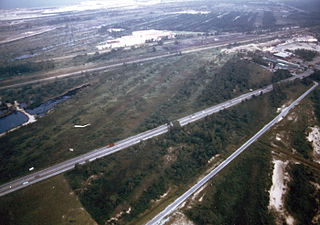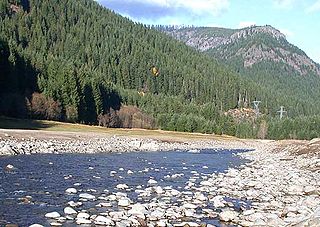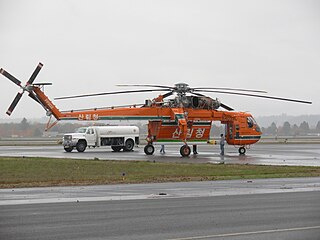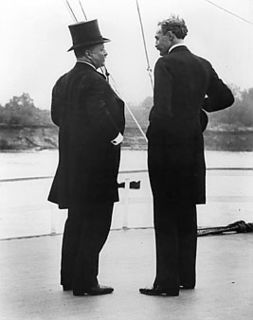Related Research Articles

The United States Forest Service (USFS) is an agency of the U.S. Department of Agriculture that administers the nation's 154 national forests and 20 national grasslands, which encompass 193 million acres (780,000 km2). Major divisions of the agency include the National Forest System, State and Private Forestry, Business Operations, and the Research and Development branch. Managing approximately 25% of federal lands, it is the only major national land agency that is outside the U.S. Department of the Interior.

Land use involves the management and modification of natural environment or wilderness into built environment such as settlements and semi-natural habitats such as arable fields, pastures, and managed woods. It also has been defined as "the total of arrangements, activities, and inputs that people undertake in a certain land cover type."

The Giant Sequoia National Monument is a 328,000-acre (1,330 km2) U.S. National Monument located in the southern Sierra Nevada in eastern central California. It is administered by the U.S. Forest Service as part of the Sequoia National Forest and includes 38 of the 39 Giant Sequoia groves that are located in the Sequoia National Forest, about half of the sequoia groves currently in existence, including one of the ten largest Giant Sequoias, the Boole Tree, which is 269 feet high with a base circumference of 112 feet. The forest covers 824 square miles.

The Willamette National Forest is a National Forest located in the central portion of the Cascade Range of the U.S. state of Oregon. It comprises 1,678,031 acres (6,790.75 km2), making it one of the largest national forests. Over 380,000 acres are designated wilderness which include seven major mountain peaks. There are also several National Wild and Scenic Rivers within the forest. The forest is named for the Willamette River, which has its headwaters in the forest. The forest headquarters are located in the city of Springfield. There are local ranger district offices in McKenzie Bridge, Detroit, Sweet Home, and Westfir.

The Resource Management Act (RMA) passed in 1991 in New Zealand is a significant, and at times, controversial Act of Parliament. The RMA promotes the sustainable management of natural and physical resources such as land, air and water. New Zealand's Ministry for the Environment describes the RMA as New Zealand's principal legislation for environmental management.

The National Wilderness Preservation System (NWPS) of the United States protects federally managed wilderness areas designated for preservation in their natural condition. Activity on formally designated wilderness areas is coordinated by the National Wilderness Preservation System. Wilderness areas are managed by four federal land management agencies: the National Park Service, the U.S. Forest Service, the U.S. Fish and Wildlife Service, and the Bureau of Land Management. The term "wilderness" is defined as "an area where the earth and community of life are untrammeled by man, where man himself is a visitor who does not remain" and "an area of undeveloped Federal land retaining its primeval character and influence, without permanent improvements or human habitation, which is protected and managed so as to preserve its natural conditions." As of 2016, there are 765 designated wilderness areas, totaling 109,129,657 acres (44,163,205 ha), or about 4.5% of the area of the United States.

The National Forest Management Act (NFMA) of 1976 is a United States federal law that is the primary statute governing the administration of national forests and was an amendment to the Forest and Rangeland Renewable Resources Planning Act of 1974, which called for the management of renewable resources on national forest lands. The law was a response to lawsuits involving various practices in the national forest, including timber harvesting., Zieske v Butz was the lawsuit brought by members of the Pt Baker Association on Prince of Wales Island against the US Forest Service's first environmental impact statement. The suit halted logging on the NW tip of the island which consisted of 400,000 acres and resulted in a call by the timber industry for Congressional action to undo the lawsuit.

The Federal Land Policy and Management Act(FLPMA), is a United States federal law that governs the way in which the public lands administered by the Bureau of Land Management are managed. The law was enacted in 1976 by the 94th Congress and is found in the United States Code under Title 43. The Federal Land Policy and Management Act phased out homesteading in the United States by repealing the pre-existing Homestead Acts.

The Santa Rosa and San Jacinto Mountains National Monument is a National Monument in southern California. It includes portions of the Santa Rosa and San Jacinto mountain ranges, the northernmost ones of the Peninsular Ranges system. The national monument covers portions of Riverside County, west of the Coachella Valley, approximately 100 miles (160 km) southeast of downtown Los Angeles.

The Korea Forest Service is charged with maintaining South Korea's forest lands. It is an independent agency specializing in forestry that is overseen by the Ministry for Food, Agriculture, Forestry and Fisheries. The current minister is Mr. Kim Jae-Hyun. The headquarters of the agency is located at the Daejeon Government Complex.
Forest management is a branch of forestry concerned with overall administrative, economic, legal, and social aspects, as well as scientific and technical aspects, such as silviculture, protection, and forest regulation. This includes management for aesthetics, fish, recreation, urban values, water, wilderness, wildlife, wood products, forest genetic resources, and other forest resource values. Management can be based on conservation, economics, or a mixture of the two. Techniques include timber extraction, planting and replanting of various species, cutting roads and pathways through forests, and preventing fire.

Land use in Oregon concerns the evolving set of laws affecting land ownership and its restrictions in the U.S. state of Oregon.

The Multiple Use - Sustained Yield Act of 1960 is a federal law passed by the United States Congress on June 12, 1960. This law authorizes and directs the Secretary of Agriculture to develop and administer the renewable resources of timber, range, water, recreation and wildlife on the national forests for multiple use and sustained yield of the products and services.

Norman Irving Wengert was an American political scientist who wrote about the politics of natural resources, advanced a seminal theory of the "politics of getting", and had a number of significant roles in his public and academic career. He was born in Milwaukee, Wisconsin to Eugene F. and Lydia Semmann Wengert. He pioneered the revival of the study of political economy in the United States with publication of Natural Resources and the Political Struggle, and later authored more than fifty monographs and studies on the political economy and public administration of environmental resources. His scholarship explored the politics of natural resources and environmental policy formation and administration, with emphases in national energy policy, urban water planning and management, land use planning and controls, national forest management, and citizen participation in administrative processes.

Starting in 1876, and undergoing a series of name changes, the U.S. Forest Service grew to protect and utilize millions of acres of forest on public land. Gifford Pinchot, an early advocate of scientific forestry, along with President Theodore Roosevelt and conservation organizations, led the effort to manage forest for the public good.

Mount Hood National Recreation Area is a 34,550-acre (13,980 ha) protected area within Mount Hood National Forest in Oregon, USA. Established on March 30, 2009 by the Omnibus Public Land Management Act of 2009, the National Recreation Area is managed by the U.S. Forest Service. It comprises three non-contiguous units, none of which include Mount Hood itself, which is within the Mount Hood Wilderness. The Mount Hood Unit lies to the southeast of Mount Hood. The Fifteenmile Unit lies directly to the east of the mountain south of Oregon Route 35, and the Shellrock Unit is to the northeast of the mountain, paralleling Route 35.
CAMPA Act or Compensatory Afforestation Fund Management and Planning Authority bill is an Indian legislation that seeks to provide an appropriate institutional mechanism, both at the Centre and in each State and Union Territory, to ensure expeditious utilization in efficient and transparent manner of amounts released in lieu of forest land diverted for non-forest purpose which would mitigate impact of diversion of such forest land.
References
![]()

The Congressional Research Service (CRS), known as Congress's think tank, is a public policy research arm of the United States Congress. As a legislative branch agency within the Library of Congress, CRS works primarily and directly for Members of Congress, their Committees and staff on a confidential, nonpartisan basis.